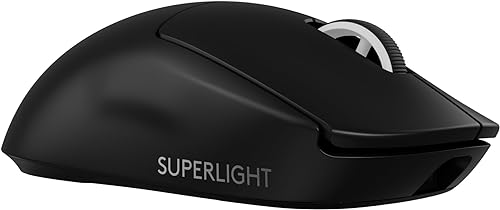As one of the lightest and most accurate first-person shooter mouse of the past several years, the Logitech G Pro X Superlight was always going to be a tough act to follow, as anyone who has played with it can attest. Amazingly, though, Logitech G has outdone itself by creating a pro gaming mouse that is faster and lighter, making it the new go-to tool for competitive players.
Users who are ready for an upgrade and are returning to the brand will find the proportions to be reassuringly familiar, even though the mouse has an enhanced sensor that is even faster and more accurate than before. In fact, one of your greatest options for success is the Logitech G Pro X Superlight 2 if milliseconds mean the difference between losing and winning.
But there’s a premium price for all that power. Be ready to spend $159, which even for a mouse of this quality is a significant sum of money.

The design and build of the Logitech G Pro X Superlight 2
The dimensions of the Logitech G Pro X Superlight 2 are precisely the same as those of its predecessor, measuring 4.92 x 2.5 x 1.57 inches. Its weight is the main change; weighing 60 grams, or slightly over 2 ounces, it is 3 grams lighter than its ancestor and feels it.
Its shape is nearly the same as the previous model, including a symmetrical body with five buttons and a medium curvature at the top that fits comfortably on the back of your hand. It fits huge paws and palm grippers perfectly because it fills the hand.
The mouse feels sleek and tiny because the two primary clicks are crammed into the mouse’s body, yet the buttons themselves still feel roomy. Two buttons on the left are high up to reduce unintentional clicks. Lightforce Hybrid switches, comprising optical and mechanical components, are used in the buttons. The optical components enable incredibly quick clicks, and the mechanical components reduce power consumption to prolong the battery life of the mouse.
With just a thin rubber strip surrounding it, the mouse wheel—which contains the other click—feels a little too light and flimsy in my opinion. It has undoubtedly been trimmed down to reduce weight, but for stability, it could have used a little more mass, similar to what the Razer DeathAdder V3 Pro has.
Any Windows 10/11 computer can be used with the Superlight 2. It makes use of a 2.4GHz Wi-Fi connection for connectivity. You get a little USB-A receiver to connect the device to Wi-Fi, and the package also includes a USB-A to USB-C adapter that you can utilize. The Logitech Pro X Superlight 2 has a battery life of up to 95 hours, which is five hours longer than the Razer DeathAdder V3 Pro.

The gaming performance of the Logitech G Pro X Superlight 2
I take a little while to speak the word “Logitech G Pro X Superlight 2,” however it only takes a split second to move my pointer from side to side on my screen. Its incredibly fine pro-grade sensor—which Logitech G says boasts sub-micron precision—is responsible for this.
Examining the Hero 2 sensor’s specifications reveals that it has a few noteworthy improvements over the Hero sensor, which was its predecessor. The improvements include a greater maximum speed of 500 inches per second, as opposed to 400 earlier, and a bump in maximum resolution from 25,600 DPI to 32,000 DPI. The 40G maximum acceleration of the mouse doesn’t change.
The maximum polling rate of the Superlight 2 is double that of the Logitech G Pro X Superlight, at 2,000Hz / 0.5ms as opposed to 1,000Hz. Anecdotally, I noticed that the mouse’s responsiveness significantly improved as a result of this enhancement.
Software for the Logitech G Pro X Superlight 2
The Logitech G Hub software is essential if you want to get the most out of your Superlight 2. It lets you assign instructions, adjust DPI and polling rate, and save these changes to the mouse’s onboard memory.
A few cutting-edge features of the Logitech G Hub truly demonstrate its value to gamers. Hero Sensor Calibration is the first feature. This spared me the trouble of having to enter my DPI settings again by enabling me to replicate them from my old favorite FPS mouse to the Superlight 2. Additionally, I liked that I could adjust the Superlight 2’s lift-off distance and set specific DPI values for.




